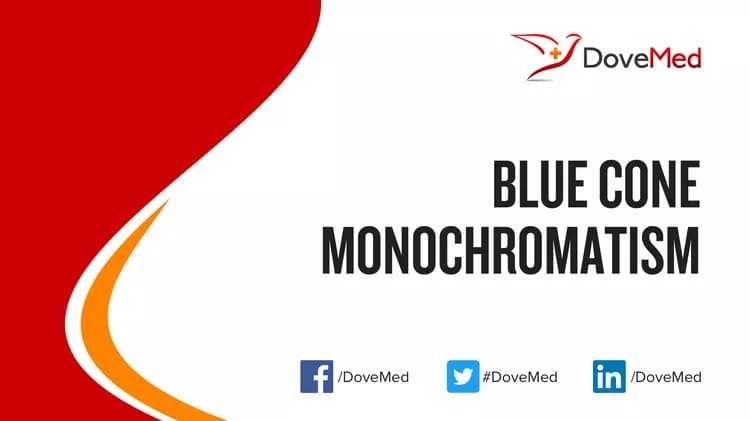What are the other Names for this Condition? (Also known as/Synonyms)
- Color Blindness Blue Mono Cone, Monochromatic type
- X-Chromosome-Linked Achromatopsia
- X-Linked Incomplete Achromatopsia
What is Blue Cone Monochromatism? (Definition/Background Information)
- Blue Cone Monochromatism (BCM) is an inherited vision disorder. In this condition, the light sensitive cells in the eye used for color vision (cones) are affected
- There are three types of cones that respond to one of three colors: red, green, and blue
- When people have Blue Cone Monochromatism, both the red and green cones do not function properly, while the blue cones work normally
- Signs and symptoms may include impaired color vision, low visual acuity (clarity or sharpness), photophobia (light sensitivity), myopia (nearsightedness), and nystagmus (fast, uncontrollable movements of the eye)
- Blue Cone Monochromatism is caused by mutations in either the OPN1LW or the OPN1MW gene(s) and is inherited in an X-linked manner
- There is no cure for this condition; however, there may be ways to manage the symptoms, such as using special glasses or contact lenses and low vision aids
(Source: Blue Cone Monochromatism; Genetic and Rare Diseases Information Center (GARD) of National Center for Advancing Translational Sciences (NCATS), USA.)
Who gets Blue Cone Monochromatism? (Age and Sex Distribution)
- Blue Cone Monochromatism is a rare congenital disorder. The presentation of symptoms may occur at birth
- Both males and females may be affected
- Worldwide, individuals of all racial and ethnic groups may be affected
What are the Risk Factors for Blue Cone Monochromatism? (Predisposing Factors)
- A positive family history may be an important risk factor, since Blue Cone Monochromatism is an inherited condition
- Currently, no other risk factors have been clearly identified for this disorder
It is important to note that having a risk factor does not mean that one will get the condition. A risk factor increases one’s chances of getting a condition compared to an individual without the risk factors. Some risk factors are more important than others.
Also, not having a risk factor does not mean that an individual will not get the condition. It is always important to discuss the effect of risk factors with your healthcare provider.
What are the Causes of Blue Cone Monochromatism? (Etiology)
- Blue Cone Monochromatism is caused by mutations in either the OPN1LW or the OPN1MW gene(s) and is inherited in an X-linked manner
(Source: Blue Cone Monochromatism; Genetic and Rare Diseases Information Center (GARD) of National Center for Advancing Translational Sciences (NCATS), USA.)
What are the Signs and Symptoms of Blue Cone Monochromatism?
The signs and symptoms of Blue Cone Monochromatism may include:
- Myopia
- Pendular nystagmus
- Reduced visual acuity
Based on the frequency of symptoms observed, the following information may be noted:
- Very frequently present symptoms in 80-99% of the cases: Blue cone monochromacy
- Frequently present symptoms in 30-79% of the cases: Nystagmus
Occasionally present symptoms in 5-29% of the cases:
- Abnormal electroretinogram
- Abnormality of macular pigmentation
- Abnormality of retinal pigmentation
- Corneal dystrophy
- Photophobia
(Source: Blue Cone Monochromatism; Genetic and Rare Diseases Information Center (GARD) of National Center for Advancing Translational Sciences (NCATS), USA.)
How is Blue Cone Monochromatism Diagnosed?
Blue Cone Monochromatism is diagnosed on the basis of the following information:
- Complete physical examination
- Thorough medical history evaluation
- Assessment of signs and symptoms
- Laboratory tests
- Imaging studies
- Biopsy studies, if necessary
Many clinical conditions may have similar signs and symptoms. Your healthcare provider may perform additional tests to rule out other clinical conditions to arrive at a definitive diagnosis.
What are the possible Complications of Blue Cone Monochromatism?
The complications of Blue Cone Monochromatism may include:
- Impaired vision
- Inability to perform certain tasks (such as driving)
Complications may occur with or without treatment, and in some cases, due to treatment also.
How is Blue Cone Monochromatism Treated?
- There is no cure for Blue Cone Monochromatism
- However, there may be ways to manage the symptoms, such as using special glasses or contact lenses and low vision aids
(Source: Blue Cone Monochromatism; Genetic and Rare Diseases Information Center (GARD) of National Center for Advancing Translational Sciences (NCATS), USA.)
How can Blue Cone Monochromatism be Prevented?
Currently, Blue Cone Monochromatism may not be preventable, since it is a genetic disorder.
- Genetic testing of the expecting parents (and related family members) and prenatal diagnosis (molecular testing of the fetus during pregnancy) may help in understanding the risks better during pregnancy
- If there is a family history of the condition, then genetic counseling will help assess risks, before planning for a child
- Active research is currently being performed to explore the possibilities for treatment and prevention of inherited and acquired genetic disorders
Regular medical screening at periodic intervals with tests and physical examinations are recommended.
What is the Prognosis of Blue Cone Monochromatism? (Outcomes/Resolutions)
- The prognosis of Blue Cone Monochromatism is dependent upon the severity of the signs and symptoms and associated complications, if any
- Individuals with mild conditions have better prognosis than those with severe symptoms and complications
- Typically, the prognosis may be assessed on a case-by-case basis
Additional and Relevant Useful Information for Blue Cone Monochromatism:
The following DoveMed website link is a useful resource for additional information:
Related Articles
Test Your Knowledge
Asked by users
Related Centers
Related Specialties
Related Physicians
Related Procedures
Related Resources
Join DoveHubs
and connect with fellow professionals


0 Comments
Please log in to post a comment.